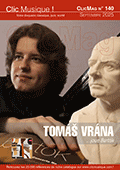 Franziska Pietsch et Detlev Etinger m’avaient bluffée dans les trois Sonates de Grieg, allaient-ils renouveler leur incroyable réussite dans les deux opus si dissemblables que Prokofiev réserva à la même formation ? Dés les premières mesures de la Sonate en fa mineur l’immense violon noir et froid – on dirait que Franziska Pietsch joue avec un archet en plomb - dit tout de cette partition tragique où Prokofiev livra ses musiques les plus désespérées, cauchemar sans remède où le piano sévère et minimaliste de Detlev Eisinger fait paraître des spectres. Fascinant, complètement inédit dans cette manière spectrale de composer le son comme le propos, en tout l’inverse de la lecture plus extravertie du tout jeune Benjamin Beilman que j’aime tant. C’est plutôt dans la lignée de Gidon Kremer que Franziska Pietsch inscrit son discours glaçant. Et pour la Seconde, qui n’est en aucun cas le chef d’œuvre qu’est la Première ? Le son s’allège, la violoniste chante en rossignol, mais garde tout de même des accents, des inflexions, une fantaisie un rien inquiète décidément bien vue dont l’original pour flûte ne laissait rien paraitre. Et quelle furia d’archet dès le second motif. Detlev Eisinger compose un orchestre de son piano. En complément, les 5 mélodies op. 35 montrent avec quel art ils savent animer les miniatures. Quels prochains opus revisiteront ces aventuriers ? Les Sonates de Bartok leur iraient comme un gant (Discophilia - Artalina.com). (Jean-Charles Hoffelé)  Following the successful release of the Grieg Violin Sonatas, Franziska Pietsch and her piano partner Detlev Eisinger now present music by Sergei Prokofiev on the audite label. His works reflect facets of her own biography to a significant degree. As an emerging talent in the GDR, Franziska Pietsch enjoyed special state support; her musical training was thus initially shaped by the Eastern European school, bringing Prokofiev’s music close to her heart. His two Violin Sonatas appear as two contrasting poles within his oeuvre – her life has also moved between extremes. The state support led to early success in the GDR. However, her father’s escape to the West in 1984 was followed by two years of reprisals by the regime, intensively shaping Franziska Pietsch’s understanding of music: deprived of any possibility of playing concerts ortaking lessons, her chosen path towards hope – against desperation, refusal, fear and despotism – led inwards. Music became the only language in which she was able to express herself freely and which gave her the necessary strength to withstand external circumstances, continuing to hope for freedom. These were the origins of the intensity and artistic depth which characterise Franziska Pietsch’s playing to the present day. The two Violin Sonatas, written largely between 1938 and 1946 after Prokofiev’s return to the Soviet Union, could not be more contrary: No. 1 in F minor, Prokofiev’s “Appassionata”, is a tragic piece, whilst No. 2 in D major, originally conceived for flute and piano, is predominantly joyful and serene. Prokofiev arranged it himself, with David Oistrakh advising him. The reworked version of the Cinq mélodies, composed in 1919/20 for voice (without text) and piano accompaniment, was also produced by Prokofiev himself. These chamber works expose three intrinsic aspects of his artistry: his ability to create a seamless, emotionally intense melodic line; his often concealed tragic side; and his classicist inclination.
 |
